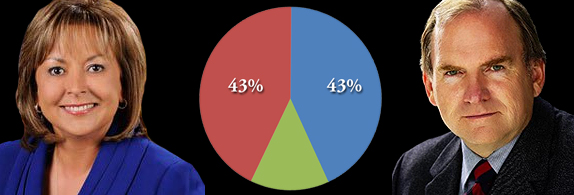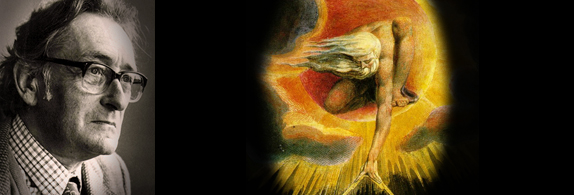King and Martinez: Tied 43% to 43%

Let’s imagine New Mexicans awake November 5 this year to find that Attorney General Gary King and his running mate Debra Haaland have won a close race against incumbent Governor Susana Martinez and Lt. Gov. John Sanchez.
It would be a stunning moment in New Mexico politics. How could such a thing have happened, we’d all be asking, given the enormous disparity in campaign war chests and the almost universal prediction that King just didn’t stand a chance.
The post-election analysis might go something like this:
It started with the Rasmussen Reports gubernatorial poll of July 24, 2014 which showed that Gary King had amazingly worked his way into a tie with the moneybags sitting governor over a month before Labor Day. It was a shocker for sure. But it made sense. Attorney General King had been forced by finances to play it low key, although he did fire back some lightning at the Governor’s slick and vicious attack ads that started up right after King had won the five candidate Democratic primary. He focused his attention on starting up his family’s deep network in New Mexico. But Governor Martinez’s attack ads hadn’t settled well with many New Mexicans either. Those ads had her attacking King for her own failings, not caring for workers, or children or education. It was absurd. And they all whistled by King like shells fired from a battleship onto a deserted island.
And New Mexicans who were bombarded with the ads during primetime didn’t like what they saw. We’re not big fans of wild negativity in New Mexico. So many times in our history it’s been the reasonable candidate that wins out even against aggressive and well-funded incumbents. The classic case in point was the stunning upset in l982 when then Attorney General Democrat Jeff Bingaman whipped the incumbent Senator, former astronaut and moon-walker Republican Harrison Schmitt. To my recollection, Schmidt held a slim lead until some national consultants advised him to go negative on Bingaman. It looked good for a moment, then it backfired big time. Bingaman, ever the reasonable candidate, appealing to reasonable New Mexicans, won going way 53.8% to Schmitt’s 46.2%.
Maybe that’s what’s happened to the incumbent governor. The screeching Martinez ads are like fingernails scratching on blackboards. They’re jarring and annoying to voters. What works in Ohio and New Jersey doesn’t work much of the time here. Or maybe King really does understand how to get out the vote with people who are long time New Mexico Democrats. Whatever happened, the Rasmussen poll energized the Democrats like little else could have. What people feared was a hopeless dream became real possibility. King was the dignified well-educated statesman. Martinez was the prosecutor turned crazed mudslinger.
If we’re imagining victory in November, we’d have to give a lot of the credit to the candidate for Lt. Gov., Deb Haaland of Leguna Pueblo, the first Native American ever to run for statewide office in New Mexico. A dignified, serious and compelling candidate who understands the real suffering of the poor and afflicted in New Mexico, Haaland brought depth and sagacity to the election. She was a powerful and positive presence on the Democratic ticket. Her counterpart, John Sanchez, remained completely overshadowed by Chris Christie’s chum running for reelection.
The King dynasty with its deep roots all over New Mexico beat out-of-state money and national Republican sloganeering which had, in the long run, little or nothing to say to New Mexicans. And the governor’s do nothing record and pathetic credit-taking for doing what the constitution requires of her – to balance the budget – made her appear to be what she was, a puppet of the Republican National Committee.
It soon became clear to undecided voters that the nastier the governor and her handlers got, the cooler and sharper and more compassionate King became.
A person who has New Mexico in his bones, he knew the state, knew what it thought, knew what it wanted, knew what it needed. The incumbent just seemed like a carpetbagger.
In the long run, the governor couldn’t get out her voters because many of them were tired of her antics and yearned to vote for a straight arrow who was one of them. Gary King and Debra Haaland filled the bill to a tee.
And on election day, November 4, no teachers voted for the governor, no state workers, no public employees anywhere in the state, no environmentalists, no LGBT activists, no artists, no poets, no one with an immigrant friend or employee and no one who follows the tragedies of the Albuquerque Police Department which is run by one of her former cabinet secretaries.
The governor alienated so many New Mexicans that the only people who voted for her were the ruling business class and not even all of them. Farmers and urban planners, governmental officials all over the state who were struggling with issues of water scarcity could not bring themselves to vote for a candidate who belonged to a political party which thinks climate change is a hoax and believes that water scarcity problems will soon straighten out when the weather returns to normal.
November 5 dawned and New Mexico had a new governor and retained the House and the Senate. Now voters were waiting to see what they would really do.
Fracking, Earthquakes, WIPP

The way people used to talk about the Waste Isolation Pilot Project (WIPP), 26 miles from Carlsbad, New Mexico in Eddy County, you’d think it was the safest most secure place on the surface of the earth, actually 2100 feet below the surface.
Something going wrong was portrayed by government and corporate PR masters as being next to preposterous, as unlikely as a meteor making a direct hit on the site, or an earthquake rattling the 170,000 radioactive canisters stored in the WIPP salt mine.
Of course, that’s what the Romans said about Mt. Vesuvius. It smoked, it gassed, it rumbled, but nothing ever happened, nor would it ever they thought, until of course it did in AD 79. Pompeii and Herculaneum were drowned in lethal volcanic ash and lava in what seemed to witnesses as only slightly more than a matter of moments. The whole population of Pompeii and the surrounding countryside was caught off guard. More than 16,000 people lost their lives, which included almost the entire population of Pompeii.
So don’t believe the experts when they brush off the idea that earthquakes could compromise the structural integrity of the salt chambers at WIPP. And don’t listen to them when they laugh scornfully at the idea that hydraulic fracturing, “fracking,” for natural gas could cause such earthquakes. The news of fracking being associated with earthquakes is rather like the rumblings of Vesuvius year after year. No one’s paid attention. And it might well be too late.
The Associated Press, not known for its liberal leanings these days, published a piece in Huffington Post two and a half weeks ago with a headline that read “States with Fracking See Surge in Earthquake Activity.” It cited an article from the journal Science that “suggests that just four wells injecting massive amounts of drilling wastewater into the ground are probably shaking up much of the state” of Oklahoma, “accounting for one out of every five quakes from the eastern border of Colorado to the Atlantic Coast.” Oklahoma has “recorded nearly 250 small-to-medium earthquakes since January….That’s close to half of all the magnitude 3 or higher earthquakes recorded this year in the continental United States” according to the U.S. Geological Survey. Oklahoma is a heavily fracked state, needless to say. West Texas experienced a 5.2 fracking induced earthquake recently.
And, as it all turns out, the one place where fracking or oil and gas drilling of any kind should be verboten, without question, is the area around WIPP. But, imagine this, there are perhaps a dozen or more fracking type wells within five miles of the WIPP site, according to Don Hancock, and many more apparently are on the way. Hancock, a long time friend of the Mercury and trusted citizen expert on WIPP, is the director of the Nuclear Waste Safety Program at the Southwest Research and Information Center in Albuquerque.
I don’t know how much money a single natural gas fracking well is expected to bring in during its lifetime, but the profits from one or one hundred or one thousand can’t possibly outweigh the astronomical expense that would result from a fracking induced structural failure at WIPP which has already cost the American taxpayers going on $20 billion with billions more projected into the future. And this doesn’t mention the possible number of lives lost to radiation contamination.
A piece in Truthout this June by Dahr Jamail asked the question “Will fracking cause our next nuclear disaster?” And the answer seems to be: don’t be surprised it if does. “The 16-square mile WIPP site is surrounded by more than 100 operating oil and natural gas wells within a mile of the boundary. There are at least 350 wells within three miles of the boundary, and the number is growing.”
Jamail quoted Hancock as saying not only are earthquakes a concern at WIPP, “but even more likely is fracking liquids nearing or entering the waste beds – which would be a very bad thing.”
Flooding WIPP or having it cracked open by an earthquake or a series of quakes could prove to be catastrophic. From what I can tell, the half mile deep WIPP caverns have on top of them a freshwater aquifer called the Rustler and a brine aquifer below them by a few hundred feet. I quote myself in The Orphaned Land, “…the early planners did not know of the six-mile-wide sinkhole between WIPP and the Pecos River, which could funnel nuclear waste very quickly from the site to the Pecos Water table” should WIPP be compromised.(Orphaned Land p. 165).
To say that WIPP is, in every sense, a calamity waiting to happen, is surely an understatement.
Charles Tomlinson

New Mexico from the l920s to the l960s had a reputation around the world of being if not exactly a magical place then at least one in which culture, land, history, and art came together in such a way as to attract great writers and other artists and scholars to its remote corners and often to the University of New Mexico. For students who worked with such creative people these experiences were shining and unforgettable moments of encounters with excellence and a “foreign” perspective that expanded our world view.
I had such an encounter in the early 1960s with the British poet Charles Tomlinson who taught an undergraduate lecture course on the English Romantic poet William Blake and his art. UNM, itself, was rich with remarkable writers and scholars. It was the self-confidence of the university’s intellectual leadership that allowed for an open arms approach to visiting scholars.
Tomlinson, an objectivist poet at the beginning of his career in the 1960s, was drawn to New Mexico, he said in an interview in the Paris Review, because of a little black and white reproduction of a painting of Georgia O’Keeffe’s. Even though in those days for Brits, America “was the place you didn’t go to.” Tomlinson had an affinity for American poets – William Carlos Williams, Marianne Moore, Wallace Stevens, Charles Olson, Robert Creeley, and Allen Ginsberg. And he found New Mexico, like so many of us have, to be irresistible. An inveterate traveler all his life, Tomlinson writes about place and describes his first trip to the United States and New Mexico as “the greatest adventure” of his young life.
He met O’Keeffe in Abiquiu when she was in her nineties. He and his young family were invited there for lunch after the painter had read a review Tomlinson had written of her work. In New Mexico, Tomlinson met southwestern archaeologists and ethnographers who introduced him to Pueblo culture and ceremonies. He traveled to Canyon de Chelly and Chaco Canyon and “caught sight of, “as he said, “some of the survivors of the D.H. Lawrence era.” He eventually traveled to Mexico, and started a life long friendship with Octavio Paz.
Some of us had heard of Tomlinson from other professors and were encouraged to take his class on Blake who had become for many young people in the counterculture a model of originality, anti-establishment liberation, and prophetic utterance. But we soon found out we didn’t know a darn thing about William Blake. But Charles Tomlinson did. Learning from him was one of those life bending experiences and joys that come from reading work you love in the company of a scholar so versed in the subject that he becomes a pathfinder. Tomlinson was such a teacher. And because he was also a painter, his lectures focused on reading Blake in the context of his illustrated manuscripts. The lectures were so eye-opening and so full of delicious detail that we literally couldn’t wait to get to class. I’ve spent time with Blake’s work pretty much every year since.
Tomlinson taught at the University of Bristol for over 30 years. And his own image became identified with his internationalism and urbanity, with his translations of Paz and Machado, his love of the American scene, the calm, clear brilliance of his own poetry of place and landscape, and with a philosophy of ideas free of “extremity” and confession. His Englishness is rooted in where he and his family have lived in Gloucestershire for many decades. It has this address: Brooke Cottage, Ozleworth Bottom, Wooten-under-Edge, Gloucester, England. As far as I know, you can reach him there to this day. Born in 1927, he is 87 years old.
Students held a deep affection for Tomlinson. A demanding teacher, he was also an influence of great kindness and generosity, corresponding with students for years, writing encouragements, and being an example of how far curiosity, intensity, and seriousness of purpose can take a student of life and the world. Watching him explore Blake, and understanding later that while Blake studies were a fascination, they were not his sole “expertise” by any means, gave us an insight into how deep one can get into a complicated subject if one really wants to, without being a “certified” expert. That lesson for me was a liberation.
He told the interviewer in the Paris Review that “I see the world in all its variety as a cause for celebration, for exultation….Let things be what they are, and that is enough for me.”
It’s still possible to find Charles Tomlinson’s New Collected Poems, Carcanet Press, 2009, to read his wonderful collection of essays called “Some Americans,” and to explore the extraordinary Oxford Book of Verse in English Translation published in l983 which he edited.
Tomlinson’s central message to students, from my perspective, is to always go deeper, always farther, driven by a refining appreciation that is a form of love. There is always more to learn, always more to find out, always more to celebrate. I’ll be forever grateful to Charles Tomlinson for that lesson.
(Nuclear danger sign by Nicolas Raymond)




Responses to “Provincial Matters, 8-4-2014”